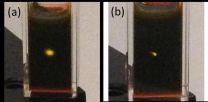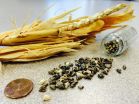Reshaping the solar spectrum to turn light to electricity
UC Riverside researchers find a way to use the infrared region of the sun's spectrum to make solar cells more efficient
2015-07-28
(Press-News.org) RIVERSIDE, Calif. -- When it comes to installing solar cells, labor cost and the cost of the land to house them constitute the bulk of the expense. The solar cells -- made often of silicon or cadmium telluride -- rarely cost more than 20 percent of the total cost. Solar energy could be made cheaper if less land had to be purchased to accommodate solar panels, best achieved if each solar cell could be coaxed to generate more power.
A huge gain in this direction has now been made by a team of chemists at the University of California, Riverside that has found an ingenious way to make solar energy conversion more efficient. The researchers report in Nano Letters that by combining inorganic semiconductor nanocrystals with organic molecules, they have succeeded in "upconverting" photons in the visible and near-infrared regions of the solar spectrum.
"The infrared region of the solar spectrum passes right through the photovoltaic materials that make up today's solar cells," explained Christopher Bardeen, a professor of chemistry. The research was a collaborative effort between him and Ming Lee Tang, an assistant professor of chemistry. "This is energy lost, no matter how good your solar cell. The hybrid material we have come up with first captures two infrared photons that would normally pass right through a solar cell without being converted to electricity, then adds their energies together to make one higher energy photon. This upconverted photon is readily absorbed by photovoltaic cells, generating electricity from light that normally would be wasted."
Bardeen added that these materials are essentially "reshaping the solar spectrum" so that it better matches the photovoltaic materials used today in solar cells. The ability to utilize the infrared portion of the solar spectrum could boost solar photovoltaic efficiencies by 30 percent or more.
In their experiments, Bardeen and Tang worked with cadmium selenide and lead selenide semiconductor nanocrystals. The organic compounds they used to prepare the hybrids were diphenylanthracene and rubrene. The cadmium selenide nanocrystals could convert visible wavelengths to ultraviolet photons, while the lead selenide nanocrystals could convert near-infrared photons to visible photons.
In lab experiments, the researchers directed 980-nanometer infrared light at the hybrid material, which then generated upconverted orange/yellow fluorescent 550-nanometer light, almost doubling the energy of the incoming photons. The researchers were able to boost the upconversion process by up to three orders of magnitude by coating the cadmium selenide nanocrystals with organic ligands, providing a route to higher efficiencies.
"This 550 -- nanometer light can be absorbed by any solar cell material," Bardeen said. "The key to this research is the hybrid composite material -- combining inorganic semiconductor nanoparticles with organic compounds. Organic compounds cannot absorb in the infrared but are good at combining two lower energy photons to a higher energy photon. By using a hybrid material, the inorganic component absorbs two photons and passes their energy on to the organic component for combination. The organic compounds then produce one high-energy photon. Put simply, the inorganics in the composite material take light in; the organics get light out."
Besides solar energy, the ability to upconvert two low energy photons into one high energy photon has potential applications in biological imaging, data storage and organic light-emitting diodes. Bardeen emphasized that the research could have wide-ranging implications.
"The ability to move light energy from one wavelength to another, more useful region, for example, from red to blue, can impact any technology that involves photons as inputs or outputs," he said.
INFORMATION:
The research was supported by grants from the National Science Foundation and the US Army.
The research was conducted also by the following coauthors on the research paper: Zhiyuan Huang (first author), Xin Li, Melika Mahboub, Kerry M. Hanson, Valerie M. Nichols and Hoang Le.
Tang's group helped design the experiments and provided the nanocrystals.
The UCR Office of Technology Commercialization has filed a provisional patent on the technology.
The University of California, Riverside (http://www.ucr.edu) is a doctoral research university, a living laboratory for groundbreaking exploration of issues critical to Inland Southern California, the state and communities around the world. Reflecting California's diverse culture, UCR's enrollment has exceeded 21,000 students. The campus opened a medical school in 2013 and has reached the heart of the Coachella Valley by way of the UCR Palm Desert Center. The campus has an annual statewide economic impact of more than $1 billion. A broadcast studio with fiber cable to the AT&T Hollywood hub is available for live or taped interviews. UCR also has ISDN for radio interviews. To learn more, call (951) UCR-NEWS.
[Attachments] See images for this press release:


ELSE PRESS RELEASES FROM THIS DATE:
2015-07-27
A Johns Hopkins-led study of outcomes among 1,200 people with implanted defibrillators -- devices intended to prevent sudden cardiac death from abnormal heart rhythms -- shows that within a few years of implantation, one in four experienced improvements in heart function substantial enough to put them over the clinical threshold that qualified them to get a defibrillator in the first place.
A report on the study, published in the Aug. 4 issue of the Journal of the American College of Cardiology, reveals these patients had markedly lower risk of dying and were far less ...
2015-07-27
In a project spearheaded by investigators at UC San Francisco, scientists have devised a new strategy to precisely modify human T cells using the genome-editing system known as CRISPR/Cas9. Because these immune-system cells play important roles in a wide range of diseases, from diabetes to AIDS to cancer, the achievement provides a versatile new tool for research on T cell function, as well as a path toward CRISPR/Cas9-based therapies for many serious health problems.
Using their novel approach, the scientists were able to disable a protein on the T-cell surface called ...
2015-07-27
Use of gene therapy to deliver a protein that suppresses the development of female reproductive organs may improve the survival of patients with ovarian cancer that has recurred after chemotherapy, which happens 70 percent of the time and is invariably fatal. In their report receiving online publication in PNAS Early Edition, a Massachusetts General Hospital (MGH) research team describes how a single injection of a modified version of Mullerian Inhibiting Substance, a protein critical to sexual development, carried on a commonly used viral vector suppressed the growth ...
2015-07-27
As many as 20 percent of people may have a benign cyst or tumor in their pituitary gland. The vast majority of pituitary tumors are noncancerous, but can cause headaches and profound fatigue, and can also disrupt hormone function. Currently, surgeons rely on radiologic images and MRIs to gather information about the size and shape of the tumor, but the resolution of such imaging technologies is limited, and additional surgeries to remove more of the tumor may be needed if a patient's symptoms persist. In a new study published in the Proceedings of the National Academy ...
2015-07-27
Estimates of how much nitrous oxide, a significant greenhouse gas and stratospheric ozone-depleting substance, is being emitted in the central United States have been too low by as much as 40 percent, a new study led by University of Minnesota scientists shows.
The study, published today in the journal Proceedings of the National Academy of Sciences, measured how much nitrous oxide is emitted from streams in an agriculturally dense area in southern Minnesota. Agriculture, and specifically nitrogen fertilizers used in row-crop farming, is a major contributor to nitrous ...
2015-07-27
SAN FRANCISCO, CALIF. - July 27, 2015 - Two new studies presented today at the Society of NeuroInterventional Surgery 12th Annual Meeting in San Francisco, report that Mobile Stroke Treatment Units (MSTUs) can significantly reduce the time it takes to diagnose and treat patients for stroke, greatly improving survival rates and enhancing a patient's chance of recovery.
There are currently four MSTUs in use worldwide. Two are in Germany and two are in the United States (U.S.) - one in Cleveland and one in Houston. MSTUs resemble ambulances on the outside, but contain ...
2015-07-27
LAWRENCE -- Providing two years of free community college to qualifying students is expected to be a hot topic during the 2016 presidential campaign.
President Barack Obama introduced the plan earlier this year, aimed at boosting educational attainment and workforce opportunities of thousands of students -- especially those from low-income families. Support for expanded education is not the purview of one party, however; President George W. Bush also frequently referenced the significance of two-year colleges. Tennessee and Oregon are offering free community college to ...
2015-07-27
MADISON, Wis. - Ten thousand years ago, a golden grain got naked, brought people together and grew to become one of the top agricultural commodities on the planet.
Now, University of Wisconsin-Madison researchers have found that just a single letter change in the genetic script of corn's ancestor, teosinte, helped make it all possible.
Publishing in the journal Genetics this month, UW-Madison professor John Doebley and a team of researchers describe how, during the domestication of corn, a single nucleotide change in the teosinte glume architectural gene (tga1) stripped ...
2015-07-27
WASHINGTON (July 27, 2015) - The improved survival rate of HIV patients in sub-Saharan Africa due to effective treatment programs is increasing the ability of researchers in Africa to study the impacts of cardiovascular disease in HIV patients, according to a guest editor page published today in the Journal of the American College of Cardiology.
According to guest editor Pravin Manga, M.B.B.C.H., Ph.D., of the University of Witwatersrand in Johannesburg, some countries in sub-Saharan Africa, like South Africa, have created highly active antiretroviral treatment programs ...
2015-07-27
Scientific experiments with the herpes virus strain that causes Marek's disease in poultry have confirmed, for the first time, the highly controversial theory that some types of vaccines allow for the evolution and survival of increasingly virulent versions of a virus, putting unvaccinated individuals at greater risk of severe illness. The research has important implications for food-chain security and food-chain economics, as well as for other diseases that affect humans and agricultural animals.
The new research, which will be published in the Open Access journal PLOS ...
LAST 30 PRESS RELEASES:
[Press-News.org] Reshaping the solar spectrum to turn light to electricity
UC Riverside researchers find a way to use the infrared region of the sun's spectrum to make solar cells more efficient


